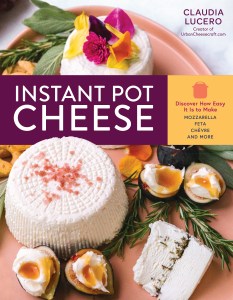How to Make Quark in an Instant Pot
A delightful substitute for yogurt or sour cream, this nutritious German cheese is easy to make at home with guidance from expert cheesemaker Claudia Lucero.
Quark was a new one to me, but I get requests for a recipe all the time. It seems that once you’ve tried this traditional German cheese, you have to keep having it! Though I’ve yet to taste a commercial version, I find this pleasantly sour, thick-yet-light cheese to be a great addition to my repertoire. I enjoy it as a dip made with sea salt, fresh scallions, and garlic, or spread on toast with strawberry or blueberry jam. There are many creative recipes online where low-fat, high-protein quark is embraced as a “diet-friendly” cheese! You can use it in place of full-fat cream cheese, yogurt, and sour cream.

Quark Cheese
Yield: 2 cups
Active Time: 10 minutes
Total Time: 20 hours
MILK TALK
Low-fat or skimmed milk is essential for quark. I like having a few recipes that use low-fat milk for those times when I make butter from nonhomogenized milk (cream-top milk) and am left with skimmed milk after I take all the cream. I have a feeling this may be how quark came to be in the first place.
Ingredients:
- ½ gallon low-fat (2%) milk, not ultra-pasteurized
- ¼ cup live, cultured buttermilk, not ultra-pasteurized
- ¼ rennet tablet dissolved in ¼ cup cool, unchlorinated water
- ½ teaspoon sea salt
Equipment:
- 6-quart Instant Pot
- 8-inch knife
- Large colander and bowl for collecting whey
- Cheesecloth
- Ladle
SAFETY CHECK
Remove the sealing ring and wash the lid thoroughly with very hot water. Leave the sealing ring off. This is a cultured product, so we want to control what grows in our milk. Sealing rings tend to hold scents (perhaps more?) with regular use. Better to be safe!
Directions:
- Add the low-fat milk to the inner pot.
- Select the Yogurt function. Adjust to Low.
- Adjust the time to 30 minutes. This will heat the milk to 86–90°F (30–32°C).
- Lock the lid on and set the steam valve to Venting.
- When the time is up or the temperature is reached (you can check the temperature sooner), add the buttermilk and stir thoroughly.
- Add 3 tablespoons of the rennet solution and stir up, down, and all around about eight times. Discard the rest of the rennet solution.
- Turn off the base. Lock the lid on and allow the milk to ferment for 12 hours. The pot is serving as insulation only. When done, the milk will be solid like firm custard with yellowish whey apparent. You may note that the curd has some cracks and has pulled away from the side of the pot. Use the knife to carefully cut the curd into columns about ½ inch thick. Cut lines ½ inch apart across the pot and then cut in the other direction like a grid.
- Line the colander with a double layer of cheesecloth and place it on the large bowl. Ladle shallow scoops of curd into the cloth. Pour the last bits of it in. Cover the colander with a plate or pot lid.
- Set the curd in a warm place (72–78°F/22–26°C) and allow to drain for at least 8 hours, or until it reaches the desired thick texture. It will thicken more when refrigerated.
- Transfer to a storage container and stir in the salt thoroughly.
Store in a covered container in the refrigerator and use within 7 days.
Excerpted and adapted from Instant Pot Cheese © Claudia Lucero.
The beloved Instant Pot can be used to do just about anything: caramelize onions, boil eggs, steam rice . . . and now, make cheese! Cheesemaking in a multicooker is not only time- and money-saving, but the cooker’s accurate and consistent temperatures make it an ideal tool for the craft. Claudia Lucero, author of the best-selling One-Hour Cheese, presents the cheesemaking basics, then covers classics such as paneer, ricotta, goat cheese, and easy cottage cheese before introducing more sophisticated options like burrata and feta, and even dairy-free alternatives. For multicookers with a “Yogurt” function, there are recipes for cultured dairy products such as buttermilk, ghee, and sour cream, too.









